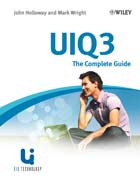
INDICE: Foreword - Peter Molin, Chief Technology Officer, UIQ Technology. Foreword - Mats Blomberg, Manager, Software Strategy, Sony Ericsson CTO Office.About the Authors. About this Book. Acknowledgements. 1. Background. 1.1 A Little History. 1.2 About UIQ Technology. 1.3 Overview of UIQ 3. 1.4 UIQ 3 Application Suite. 1.5 Technologies and Features in the UIQ Platform. 1.6 UIQ 3 Development Platform. 1.7 UIQ Ecosystem. 2. Chapter 2 UIQ 3 Basics. 1.8 UI Configuration. 1.9 Building Blocks and Layout Manager. 1.10 Layout Managers. 2.4 UIQ3 Operational Model. 2.5 View Layout Construction. 2.6 Changes from UIQ 2.1 to UIQ 3. 2.7 Changes from UIQ 3.0 to UIQ 3.1. 2.8 UIQ 3.2. 3. Quick Start. 1.11 Introduction. 1.12 Development Environment . 1.13 The QuickStart Example. 1.14 Building from the Command Line. 1.15 Running on the Emulator. 1.16 Packaging for the Phone. 1.17 Using Carbide.c++. 4. Symbian OS Essentials. 4.1. What this Chapter Covers. 4.2. Symbian OS Versions. 4.3. Symbian OS Code Conventions. 4.4. Symbian OS Class Types. 4.5. Leaves and the Cleanup Stack. 4.6. Panics,Assertions and Leaves Compared. 4.7. Construction and Destruction. 4.8. Descriptors: Symbian OS Strings. 4.9. Arrays. 4.10 Templates. 4.11 Active Objects and Threads. 4.12 The Client-Server Framework. 4.13.System Information. 4.14.Platform Security. 5. Understanding User Interface Components. 5.1 Controls and Windows. 5.2 The Control Environment. 5.3 Views and the View Server. 5.4 Anatomy of the Screen. 6. List Boxes. 6.1 ListView1 Application. 6.2 ListView2. 7. Commands and Categories. 7.1 Commands Overview. 7.2 Commands1 Example Application. 7.3 Categories. 7.4 Further information. 8. Layout Managers and Building Blocks. 8.1 Layout Managers. 8.2 Building Blocks. 9. Chapter 9 Views and Dialogs. 9.1 Overview. 9.2 Working with Views. 9.3 Views and Dialogs. 10. Building An Application. 10.1 Symbian Signed. 10.2 Starting Our Project: SignedAppPhase1. 10.3 SignedAppPhase2. 10.4 Building your Application for Deployment. 11. Multimedia. 11.1 SignedAppPhase3. 11.2 Symbian Signed Requirements. 11.3 Images.11.4 Alternative Image Support: CqikContent. 11.5 Camera. 11.6 Multimedia Framework (MMF). 11.7 Audio. 11.8 Video. 11.9 Tuner API. 12. Communications. 12.1Communications Technologies. 12.2 Symbian OS Communications Architecture. 12.3 Sockets. 12.4 Bluetooth Technology. 12.5 HyperText Transfer Protocol. 12.6 Messaging Architecture. 12.7 The Send As Interface. 12.8 Telephony. 13. Refining Your Application. 13.1 Application Localization: Language. 13.2 Internationalization. 13.3 Application Performance. 13.4 Other Considerations. 14. SymbianSigned. 14.1 Introduction to Symbian Signed. 14.2 Application Origin. 14.3 Capabilities. 14.4 Routes to Symbian Sign Your Application. 14.5 Procedural Impact. 14.6 Getting Started with Symbian Signed. 14.7 Submission and Compliance Criteria. 14.8 Symbian Signed Test Criteria. 14.9 Lessons Learned. 15. Testing,Debugging and Deploying. 15.1 Back to Basics. 15.2 Testing. 15.3 Debugging. 15.4 Deploying. 15.5 Summary. 16. Porting Applications. 16.1 Where to Start. 16.2 The Aims of Porting. 16.3 General Porting Considerations. 16.4 General Porting Techniques. 16.5 Porting from a Standard C/POSIX Style Environment. 16.6 Porting from Palm OS and Windows Mobile. 16.7 Porting from S60 3rd Edition. 16.8 Summary. 17. Further Resources. 17.1 Wiki Site. 17.2 Developer Resources. 17.3 References. 17.4 Glossary. Index.
- ISBN: 978-0-470-69436-7
- Editorial: John Wiley & Sons
- Encuadernacion: Rústica
- Páginas: 680
- Fecha Publicación: 20/06/2008
- Nº Volúmenes: 1
- Idioma: Inglés
